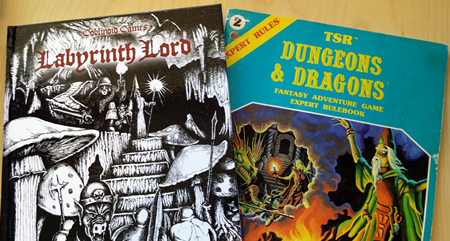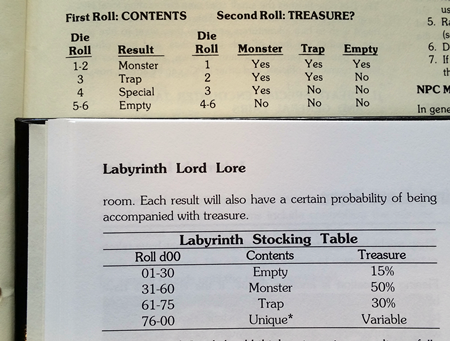Wayne Rossi wrote an excellent post, Clones and Rules, Inside and Out, about the apparently subtle differences between some retroclones and their sources which, in fact, produce non-subtle differences in play. Here’s an excerpt, from his comparison of OD&D (paid link) dungeon stocking to Swords & Wizardry dungeon stocking:
An OD&D dungeon designed according to its guidelines is going to have “unguarded” treasure. According to the book it should be hidden and/or trapped. But a S&W dungeon isn’t going to have that, if the referee follows the guidelines in the S&W rule books. Over time the game is going to play differently, since the OD&D group is going to be looking for hidden treasure while the S&W group would be justified in looking for combat.
Wayne is one sharp dude, and he has a knack for noticing stuff, prying it apart, and being able to succinctly share what makes it tick. (His OD&D Setting PDF, which I blogged about here on Yore, is a marvelous example of this — and a great read.)
His comparison of S&W to OD&D got me thinking about my favorite flavor of D&D, Moldvay/Cook (B/X) (paid link), and its closest OSR analog, Labyrinth Lord. I wondered whether or not they differed in the area of dungeon stocking, and I realized I wasn’t sure — I’d just assumed they were pretty much identical.
But what if they weren’t? What if B/X and LL diverged in the same way as OD&D and S&W, or in a different subtle-but-significant way? Let’s take a peek.

Dungeon stocking
Both B/X and LL sum up dungeon stocking in one chart (plus a bit of explanatory text nearby), making them easy to compare. Here’s page X53’s chart from the Expert Set above page 124’s chart from LL.

They both use the same four categories: monster, trap, special (which LL calls “unique”), and empty. They also both employ two die rolls: d6 followed by d6 in B/X, and d% followed by d% in LL. LL’s chart is a bit cleaner, both because it uses percentages (which I find more intuitive to assess than fractions) and because of its layout.
Room contents
Broadly speaking, the percentages for room contents are about the same — except in one case:
- Monster: 33.33% chance in B/X, 30% chance in LL
- Trap: 16.67% in B/X, 15% in LL
- Special/Unique: 16.67% in B/X, 25% in LL
- Empty: 33.33% in B/X, 30% in LL
The chance of a room being empty or having a monster in it are close enough to identical to call them the same — about 30%. Ditto the chance of a trap, about 15%.
What’s different is the chance of a special/unique room, 1 in 6 for B/X vs. 1 in 4 for LL. That’s not a huge difference, but it’s a difference.
What about the chance of treasure?
Treasure
Here are the percentages for the chance of treasure being present in each system:
- Monster: 50% chance in B/X, 50% chance in LL
- Trap: 33.33% in B/X, 30% in LL
- Special/Unique: Undefined in B/X, “Variable” in LL — essentially the same thing
- Empty: 16.67% in B/X, 15% in LL
For all practical purposes, those percentages are identical.
Conclusions
B/X D&D and Labyrinth Lord are essentially the same game with respect to dungeon stocking, the chance for a given room to be empty or otherwise, and the chance for there to be treasure in the room.
The only meaningful difference is that you’re somewhat more likely to encounter a special/unique room in LL than you are in B/X (and, consequently, slightly less likely to have the other possible contents come up).
To me, this is evidence of a shared design goal: Give the players a meaningful choice when it comes to seeking out treasure. Which makes sense, because both systems share the same XP methodology: 1 XP for 1 GP, plus XP for monsters, with the bulk of your XP coming from gold.
Dungeon rooms with monsters in them are more likely to have treasure than any other types of room, but you have to deal with the monster (which is itself worth XP). Empty rooms have the lowest chance of yielding treasure, which makes searching them — and expending resources in the form of time, torches, and wandering monster checks — risky in and of itself, but if you’re lucky you find unguarded treasure.
LL incentivizes the same style of play as B/X, which is a testament to its clarity of purpose as a B/X retroclone.
I also like that the one real difference, special rooms, would give an LL-designed dungeon its own flavor when compared to a B/X-designed dungeon. The party would run into a couple more special rooms, and special rooms are neat. There’s a philosophical difference there, albeit a subtle one.
